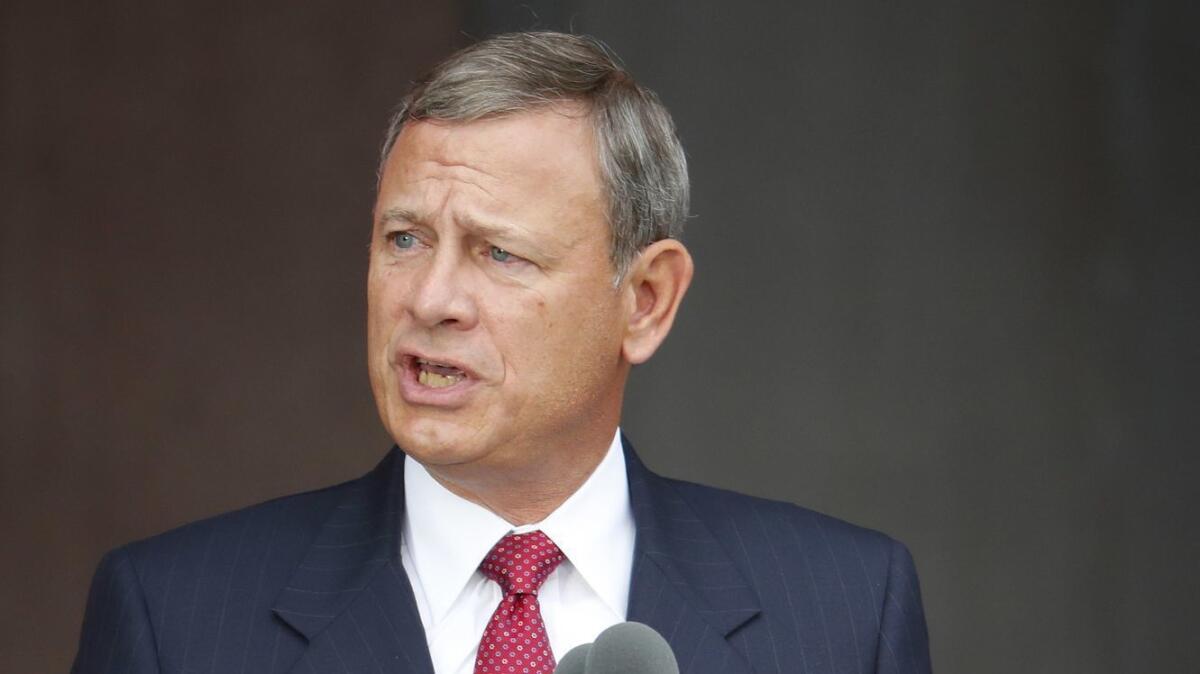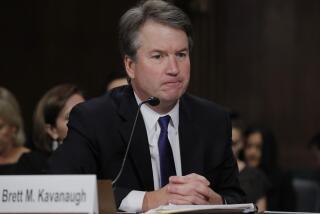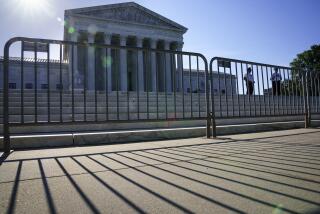Chief Justice Roberts lauds progress against sexual harassment by federal judges

Reporting from Washington — Federal judges sometimes have to decide cases involving sexual harassment and abuse in the workplace.
In the past year, however, the court system has had to look inward at an equally wrenching problem: powerful judges who harass and abuse law clerks and other employees in the privacy of chambers.
Chief Justice John G. Roberts Jr. devoted his year-end report on the judiciary to describing how the nation’s top judges had investigated the problem of workplace abuse and adopted policies to prevent it.
It comes a year after Judge Alex Kozinski abruptly stepped down from the 9th Circuit Court of Appeals in California after multiple women accused him of making crude sexual comments, including the displaying of pornography on his office computer.
Their reports embarrassed the judiciary because many of the women said they felt trapped and had no effective way to complain about the abuse. Though former clerks had traded accounts of Kozinski’s inappropriate behavior for many years, nothing was done until their complaints appeared in news stories.
Roberts said that the study group he appointed found that — based on input from employees, advisory groups and court surveys — inappropriate workplace conduct is “not pervasive,” but also “not limited to a few isolated instances involving law clerks.” It also determined that “misconduct, when it does occur, is more likely to take the form of incivility or disrespect than overt sexual harassment, and it frequently goes unreported.”
The federal courts have 677 district judges and 179 appellate judges, along with nine justices of the Supreme Court. And for the most part, they work independently with the help of several clerks and aides.
Roberts said the judiciary plans to revise its codes of conduct to “state explicitly what has always been implicit in them: Judges and judicial employees may not engage in abusive or harassing behavior; must be civil and respectful in dealings with coworkers and subordinates; and may not engage in retaliation against persons who report misconduct.”
Moreover, judges and court employees will have an obligation “to report observed misconduct to those who can take action to stop it,” he said. The revised policy will “also make clear that the duties of confidentiality shared by judges, law clerks and court employees do not pose any obstacle to reporting or disclosing misconduct.”
The Constitution says federal judges hold “their offices during good behavior,” and the chief justice did not describe how the judiciary would discipline judges who are accused of abusing employees.
While lauding the progress in the past year, Roberts said, “I also realize that the job is not yet done. I have directed the working group to remain in place over the next year to monitor the progress and success of those efforts. The job is not finished until we have done all that we can to ensure that all of our employees are treated with fairness, dignity and respect.”
The chief justice made no mention of the recent controversies that have swirled around the courts, including his rebuke of President Trump for Trump’s reference to an “Obama judge” in San Francisco who had blocked a White House order limiting asylum claims.
“We do not have Obama judges or Trump judges, Bush judges or Clinton judges,” Roberts said in response to the president’s comment. “What we have is an extraordinary group of dedicated judges doing their level best to do equal right to those appearing before them.”
Last week, the Supreme Court by a 5-4 vote, with Roberts in the majority, turned down the Trump administration’s appeal seeking to have the judge’s order lifted.
This week marks the end of the 115th Congress, which confirmed 85 new Trump appointees to the federal courts in 2017 and 2018. They included 30 appellate judges and 53 district judges as well as Justices Neil M. Gorsuch and Brett M. Kavanaugh for the Supreme Court.
This stands in sharp contrast to the 114th Congress, which confirmed only 20 judges, the lowest total since 1952. Senate Republicans used a narrow majority to block most of President Obama’s court appointees in 2015 and 2016, including Supreme Court nominee Judge Merrick Garland. They then moved rapidly to approve most of Trump’s judicial candidates in the last two years.
During his first two years in office, Obama had a solid Democratic majority in the Senate but did not quite match Trump’s record. In 2009 and 2010, the Senate confirmed 62 judges, including 16 appellate judges as well as Justices Sonia Sotomayor and Elena Kagan.
But the filibuster was in place then for judicial picks, and it allowed objecting Republicans to slow down the process. Democrats in 2013 abandoned the filibuster for judicial appointments, except for the Supreme Court. Republicans stopped using filibusters for Supreme Court nominees, too, when they took control of the Senate.
More stories from David G. Savage »
Twitter: DavidGSavage
More to Read
Get the L.A. Times Politics newsletter
Deeply reported insights into legislation, politics and policy from Sacramento, Washington and beyond. In your inbox three times per week.
You may occasionally receive promotional content from the Los Angeles Times.











